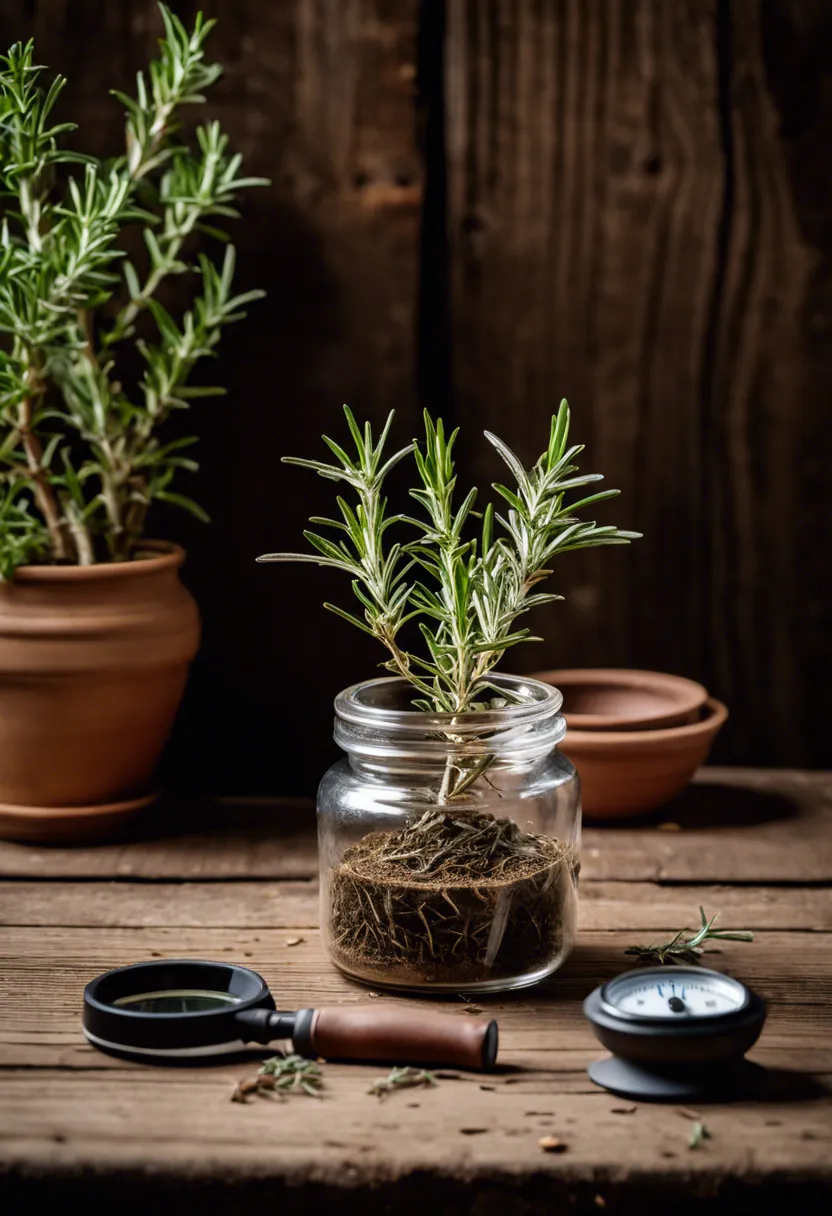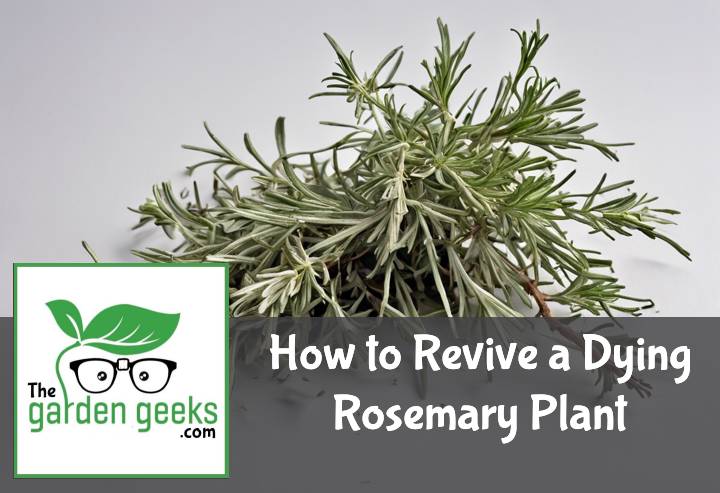Did you know that rosemary, a commonly used herb in cooking, is also known for its resilience and longevity? Yet, even the toughest plants can fall victim to poor conditions. If you’re noticing your rosemary plant looking a bit under the weather, don’t fret!
In this guide on How to Revive a Dying Rosemary Plant, we’ll walk you through identifying the symptoms of a dying rosemary plant and how to nurse it back to health.
So buckle up and get ready for some plant-saving tips. Keep reading about How to Revive a Dying Rosemary Plant.
Quick Answer
- Identify the signs of a dying rosemary plant, such as wilting or yellowing leaves and poor root health.
- Understand the causes of decline, including improper watering, insufficient sunlight, nutrient deficiencies in the soil, and pests or diseases.
- Revive your rosemary plant by adjusting watering practices, ensuring it gets enough sunlight but not too much heat, enriching the soil with necessary nutrients, and treating any pest infestations or diseases.
- Prevent future issues by learning proper watering techniques and providing appropriate sunlight and temperature conditions.

Identifying the Signs of a Dying Rosemary Plant
Catching the early signs of dying rosemary can be the lifesaver your plant needs. Let’s dive into what to look out for.
Visual Symptoms
When your rosemary starts looking sad, it’s time to play detective. First off, if the leaves are changing color, that’s clue number one. Rosemary leaf discoloration, like leaves turning yellow or brown, is a big red flag. This usually means your plant is either too thirsty or drowning in water.
Next up, check if your plant is wilting or if those once perky branches are now drooping sadly. A wilting rosemary plant often feels dry and might crumble when you touch it. This could mean it’s not getting enough water or love from you.
Also, keep an eye out for brown spots on leaves or any parts that seem mushy. These could be signs of disease or damage from too much sun.
Lastly, if the whole plant looks tired and just not its happy self, with leaves turning yellow (yellowing rosemary leaves), it’s screaming for help. It might be stressed from too much heat or not enough light.
Root Health and Soil Condition
Now let’s talk about what’s happening underground because healthy roots mean a happy rosemary plant. If you pull your plant out gently and see roots that are dark and mushy, that’s rosemary root rot talking. It usually happens when there’s too much water hanging around with nowhere to go.
On the flip side, roots that look dry and brittle aren’t getting enough water. They need moisture to stay strong and grab nutrients from the soil.
Speaking of soil, if it feels hard as a rock (compacted soil problems), your rosemary is suffocating down there. Roots need loose soil to breathe and grow.
Too much water can lead to soggy conditions which are bad news bears for roots (overwatering effects on roots). But don’t swing too far the other way; soil that’s dry as dust (under-watering effects on soil condition) won’t do your plant any favors either.
A healthy root system looks white or tan with lots of little offshoots. That’s what you want to see – a network of strong roots ready to support a thriving rosemary plant.
Causes of Decline in Rosemary Plants
Understanding why your rosemary plant might be looking sad is the first step to getting it back on its feet. Let’s dive into the common culprits.
Watering Issues
Water can be a tricky friend or foe to your rosemary plant. Too much love in the form of water, and you’ll find yourself with an overwatered rosemary showing signs like yellow leaves that feel soft. On the flip side, not enough water leads to a thirsty, underwatered rosemary with droopy, dry leaves. The trick is finding that Goldilocks zone of just right.
To fix watering issues in rosemary plants, start by checking the soil before you water. If it’s damp, wait a bit longer. If it’s dry, give it a drink. Remember, rosemary likes to keep its feet dry between watering sessions.
Sunlight and Temperature Stress
Rosemary plants are like sunbathers; they love soaking up those rays. Not enough light can make them weak and leggy. Aim for at least 6-8 hours of direct sunlight each day for a happy plant.
But just like us, too much of a good thing can be bad. Extreme heat or cold can stress your plant out. Keep your rosemary in conditions that mimic their Mediterranean home—warm days and cool nights. Protect them from frosty temperatures and scorching summer afternoons.
Soil Nutrient Deficiencies
Think of soil as your rosemary’s dinner plate. If it’s lacking in nutrients, your plant won’t get the food it needs to thrive. Poor nutrition can lead to weak growth and dull-colored leaves.
To combat nutrient deficiencies in herbs, mix some compost or organic fertilizer into your soil at planting time and periodically throughout the growing season. This will give your rosemary all the goodies it needs for strong growth.
Pests and Diseases
Even the strongest plants can fall victim to tiny invaders or sicknesses. Common rosemary pests include spider mites and aphids, which suck the life out of your plant’s leaves.
For diseases, watch out for root rot caused by too much water or powdery mildew from high humidity levels around the foliage.
Prevention is key: ensure good air circulation around your plants and avoid overhead watering to keep leaves dry. If pests or diseases strike, treat promptly with appropriate organic options to minimize damage.



How to Revive Your Dying Rosemary Plant


Reviving a dying rosemary plant might seem like a task for a magician, but guess what? You’ve got the magic in your hands! With just a few steps, you can breathe life back into your plant and have it thanking you with its fragrant leaves. Let’s get that rosemary from “Oh no!” to “Grow, baby, grow!”
-
Check the soil moisture: First things first, poke your finger into the soil about an inch deep. If it feels dry as a desert, your plant is thirsty! Give it a good drink of water until the soil is moist but not soggy. Remember, rosemary plants hate wet feet!
-
Assess sunlight exposure: Rosemary loves the sun more than a cat loves a warm lap. Make sure your plant is getting at least 6-8 hours of direct sunlight daily. If it’s not, move it to a sunnier spot where those rays can work their magic.
-
Trim dead parts: Sometimes, you gotta be cruel to be kind. Use clean scissors or pruning shears to snip off any dead or dying branches and leaves. This helps the plant focus its energy on the healthy parts.
-
Adjust watering habits: Over-watering is often the culprit behind a dying rosemary plant. Let the top inch of soil dry out before watering again. And always check for proper drainage – no swimming pools at the bottom of your pot!
-
Improve air circulation: Rosemary doesn’t like to feel crowded or stuffy. Make sure there’s plenty of space around your plant for air to circulate freely. This helps prevent fungal diseases that thrive in damp conditions.
-
Fertilize sparingly: Too much love in the form of fertilizer can overwhelm your rosemary. Feed it with a balanced, slow-release fertilizer once at the beginning of its growing season – and then let it do its thing.
-
Repot if necessary: If your rosemary has outgrown its current home or if you suspect root rot (a common issue with poor drainage), gently repot it into fresh soil and a slightly larger pot with good drainage holes.
By following these steps, you’re not just reviving your rosemary; you’re setting it up for thriving success!
Preventative Measures for Future Health
Taking care of your rosemary plant starts with preventative measures. It’s all about the right watering techniques and giving it enough sunlight.
Proper Watering Techniques
Rosemary plants hate having wet feet. That means too much water is a no-no. You want to water your rosemary only when the soil feels dry to the touch. Stick your finger in the soil, about an inch deep. If it feels dry, it’s time to water. This simple check helps prevent overwatering.
Water deeply but infrequently. When you do water, make sure you’re giving enough so that it reaches the roots where it counts. But then, let the soil dry out before watering again. This method ensures your rosemary gets the proper hydration without drowning.
Remember, rosemary is more like a cactus than a fern in its water needs. It thrives on neglect rather than constant attention. So, if you’re someone who tends to over-love your plants with too much water, take a step back. Let your rosemary breathe and drink up at its own pace.
Appropriate Sunlight and Temperature Conditions
Rosemary loves the sun; think Mediterranean vibes where this herb originates from. Aim for at least 6-8 hours of direct sunlight each day for optimal growth. If you’re growing it indoors, a south-facing window is prime real estate for your plant.
But here’s the kicker – while rosemary loves basking in the sun, it doesn’t enjoy extreme heat or cold. Keep temperatures around 60-70°F (15-21°C) during the day and not below 30°F (-1°C) at night to keep your plant happy.
If you live in a cooler climate, bringing your rosemary indoors during winter months can save its life. Just make sure it still gets plenty of light by placing it near a sunny window or under grow lights.
Balancing sunlight exposure and maintaining moderate temperature conditions are key to avoiding stress on your plant which can lead to health issues down the line.
To Wrap Up
So, we’ve learned that rosemary plants are a bit like Goldilocks. They don’t want too much water, or too little, but just the right amount! And they love sunshine and well-drained soil.
If your plant is looking sickly, don’t panic! You now know How to Revive a Dying Rosemary Plant with some TLC and patience.
Remember, it’s okay if you mess up. Plants can be tricky sometimes. Keep trying and don’t give up on your green thumb!


FAQs about ‘How to Revive a Dying Rosemary Plant’.
What are the common pests and diseases that affect rosemary plants?
Common pests include aphids, whiteflies, and spider mites. Diseases often include root rot caused by overwatering, or fungal infections due to high humidity.
How often should I water my rosemary plant?
Rosemary plants prefer drier conditions. Water them deeply but infrequently, allowing the soil to dry out between watering sessions.
Can a rosemary plant recover from root rot?
Yes, it can. However, it requires immediate action. You’ll need to remove the affected roots and repot the plant in fresh soil.
Does a rosemary plant need direct sunlight?
Rosemary plants thrive in full sun but can tolerate partial shade. They require at least 6-8 hours of sunlight per day for optimal growth.
What type of soil is best for growing rosemary plants?
Rosemary prefers well-draining soil with a pH between 6.0 and 7.0. A sandy or loamy soil enriched with organic matter works best.
Can I use regular garden fertilizer for my rosemary plant?
While you can use general-purpose garden fertilizer, it’s better to use one specifically designed for herbs as they have different nutrient requirements.
How do I know if my rosemary plant is getting enough sunlight?
If your rosemary isn’t getting enough sunlight, it may start to look leggy with long stems and fewer leaves. It may also grow slower than usual.
How can I prevent pests from attacking my rosemary plant?
Regular inspection and proper care are key. Also consider using natural pest deterrents like neem oil or introducing beneficial insects like ladybugs into your garden.


